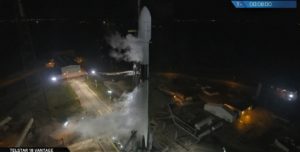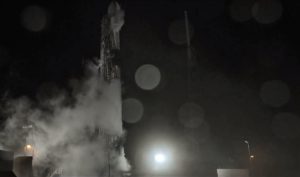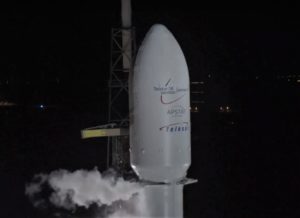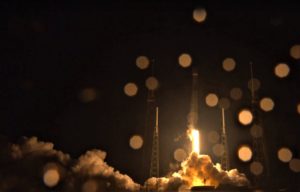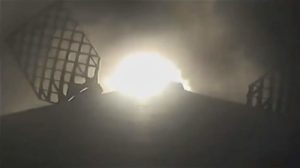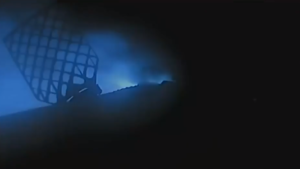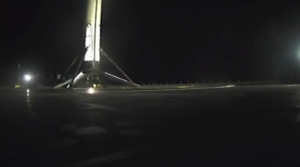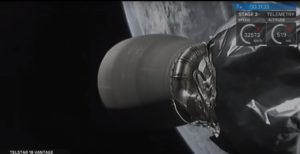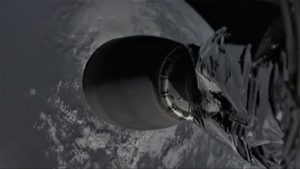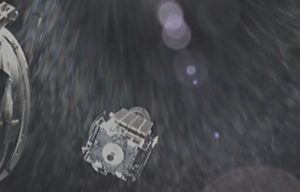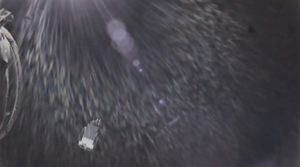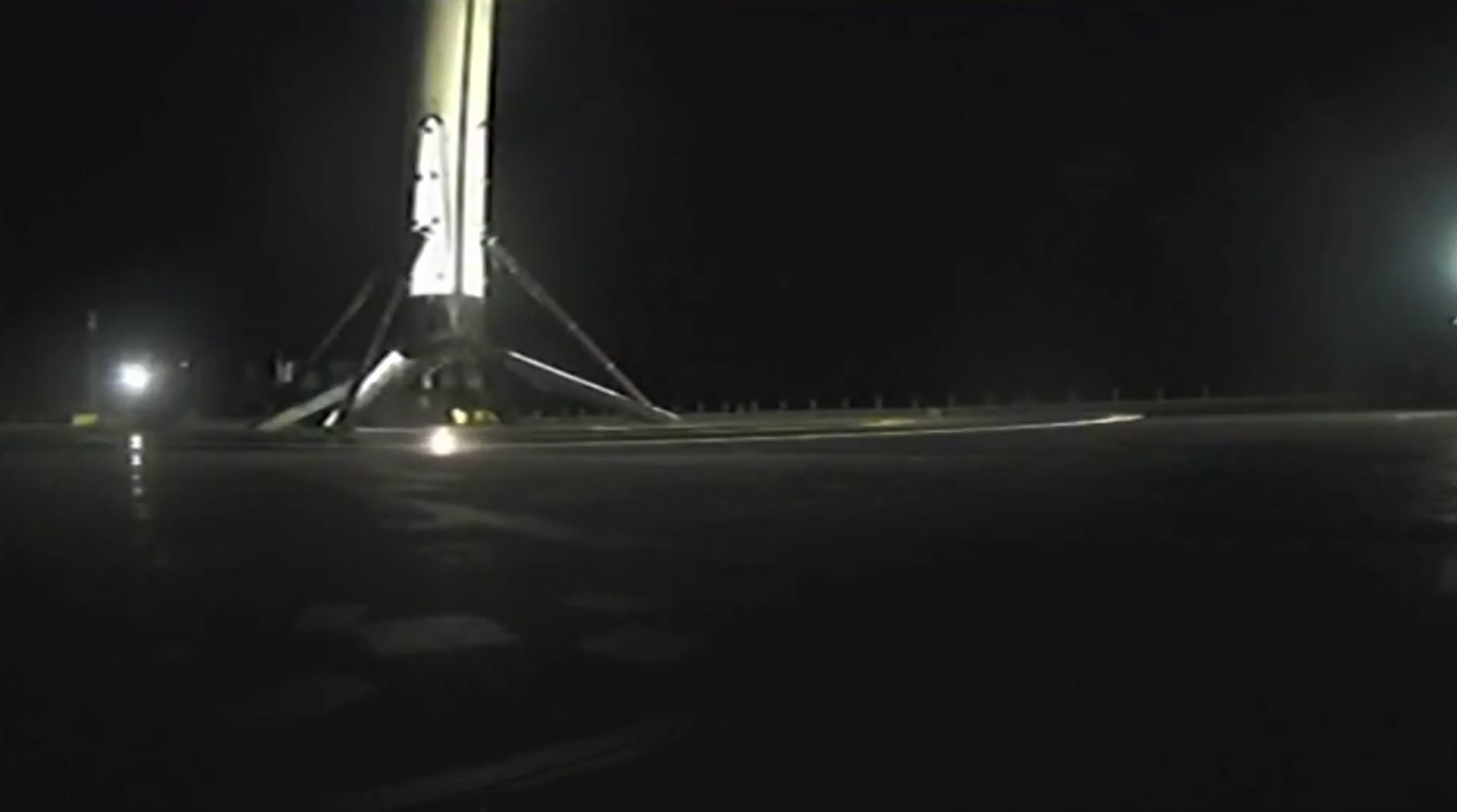

SpaceX
SpaceX bags 60th successful Falcon 9 launch eight years after rocket’s debut
Following the successful separation of the ~7 metric ton satellite Telstar 18V after a nominal orbit insertion, SpaceX’s venerable Falcon 9 rocket can now lay claim to a full 60 successful orbital missions completed over the course of its relatively brief eight-year career as a commercial launch vehicle.
Telstar 18V – the second heaviest commercial satellite ever launched into orbit – is now free to make its way into a final geostationary orbit ~35,800 km (~22,250 mi) above Earth’s surface, where it will serve the Eastern Hemisphere with a variety of communications services, ranging from TV to internet.
https://twitter.com/_TomCross_/status/1039020007987077121
After Falcon 9’s upper stage separated from the first stage and pushed onwards to a low Earth parking orbit, Falcon 9 Block 5 booster B1049 flipped around using an array of powerful cold-gas nitrogen thrusters and arced towards a now-routine drone ship landing roughly 700 kilometers off the Florida coast, breaking the satellite communications link as per usual before appearing aboard Of Course I Still Love You.
With Hurricane Florence nipping at the drone ship and its entourage’s heels, SpaceX will likely try to quickly usher the Falcon 9 booster back to Port Canaveral, where it will be offloaded, brought horizontal, and transported to a local facility for refurbishment ahead of its next flight, hopefully the first of many to come. Falcon 9 Block 5 has been designed – nominally – for rapid and extensive reusability, perhaps up to 100 flights per booster with routine maintenance (10 flights with minimal refurbishment) and turnaround as rapid as 24 hours for the same core. While it appears that there may be a significant amount of work left before those aspirational figures can be made real, Block 5 is clearly a major step forward for the Falcon 9 family and includes – aside from reusability – upgrades that will enable the rocket to launch NASA astronauts aboard Crew Dragon with extreme reliability.
- Falcon 9 B1049 and Telstar 18V. (SpaceX)
- Falcon 9 B1049 and Telstar 18V. (SpaceX)
- Falcon 9 B1049 and Telstar 18V. (SpaceX)
- Liftoff! (SpaceX)
- Falcon 9 B1049 completes its reentry burn. (SpaceX)
- Falcon 9 B1049 completes its reentry burn. (SpaceX)
- B1049 stands proud after a successful landing aboard drone ship OCISLY. (SpaceX)
- Falcon 9’s upper stage seen in orbit shortly after launch. (SpaceX)
- Falcon 9’s upper stage seen in orbit shortly after launch. (SpaceX)
- The 7060 kg Telstar 18V drifts gracefully away from Falcon 9 S2 into orbital glare. (SpaceX)
- The 7060 kg Telstar 18V drifts gracefully away from Falcon 9 S2 into orbital glare. (SpaceX)
- (Tom Cross)
Compared alongside almost all other modern rockets, Falcon 9 is exceptional for the sheer speed with which it has burst onto the commercial launch scene, with Boeing’s nearly-retired Delta II family of rockets the only vehicle to hold a candle to Falcon 9 in terms of competitive advantage. Delta II, which debuted in 1989, managed a thoroughly impressive seven launches in its first year of operations and a full 55 launches (53 successes, 1 partial failure, 1 total failure).
With one partial in-flight failure (a secondary payload loss during CRS-1), one total in-flight failure (CRS-7), and one on-pad failure (Amos-6), Falcon 9 is truly comparable with Delta II, although Boeing’s expendable launch vehicle has, of course, remained permanently expendable, and relied almost unilaterally upon the US government for all but a small handful of its first several dozen launches. SpaceX’s Telstar 18V success is just one of many examples of this difference of interest in commercial competition, and a full 12 of the 16 missions SpaceX has now launched in 2018 flew commercial satellites and were awarded to the launch company on a competitive basis.
https://twitter.com/_TomCross_/status/1039031282339127297
Up next for SpaceX is Argentinian Earth observation satellite SAOCOM-1A, scheduled to launch from California’s Vandenberg Air Force Base atop a flight-proven Falcon 9 Block 5 booster no earlier than October 7th.
For prompt updates, on-the-ground perspectives, and unique glimpses of SpaceX’s rocket recovery fleet check out our brand new LaunchPad and LandingZone newsletters!
News
SpaceX launches Ax-4 mission to the ISS with international crew
The SpaceX Falcon 9 launched Axiom’s Ax-4 mission to ISS. Ax-4 crew will conduct 60+ science experiments during a 14-day stay on the ISS.

SpaceX launched the Falcon 9 rocket kickstarting Axiom Space’s Ax-4 mission to the International Space Station (ISS). Axiom’s Ax-4 mission is led by a historic international crew and lifted off from Kennedy Space Center’s Launch Complex 39A at 2:31 a.m. ET on June 25, 2025.
The Ax-4 crew is set to dock with the ISS around 7 a.m. ET on Thursday, June 26, 2025. Axiom Space, a Houston-based commercial space company, coordinated the mission with SpaceX for transportation and NASA for ISS access, with support from the European Space Agency and the astronauts’ governments.
The Ax-4 mission marks a milestone in global space collaboration. The Ax-4 crew, commanded by U.S. astronaut Peggy Whitson, includes Shubhanshu Shukla from India as the pilot, alongside mission specialists Sławosz Uznański-Wiśniewski from Poland and Tibor Kapu from Hungary.
“The trip marks the return to human spaceflight for those countries — their first government-sponsored flights in more than 40 years,” Axiom noted.
Shukla’s participation aligns with India’s Gaganyaan program planned for 2027. He is the first Indian astronaut to visit the ISS since Rakesh Sharma in 1984.
Axiom’s Ax-4 mission marks SpaceX’s 18th human spaceflight. The mission employs a Crew Dragon capsule atop a Falcon 9 rocket, designed with a launch escape system and “two-fault tolerant” for enhanced safety. The Axiom mission faced a few delays due to weather, a Falcon 9 leak, and an ISS Zvezda module leak investigation by NASA and Roscosmos before the recent successful launch.
As the crew prepares to execute its scientific objectives, SpaceX’s Ax-4 mission paves the way for a new era of inclusive space research, inspiring future generations and solidifying collaborative ties in the cosmos. During the Ax-4 crew’s 14-day stay in the ISS, the astronauts will conduct nearly 60 experiments.
“We’ll be conducting research that spans biology, material, and physical sciences as well as technology demonstrations,” said Whitson. “We’ll also be engaging with students around the world, sharing our experience and inspiring the next generation of explorers.”
SpaceX’s Ax-4 mission highlights Axiom’s role in advancing commercial spaceflight and fostering international partnerships. The mission strengthens global space exploration efforts by enabling historic spaceflight returns for India, Poland, and Hungary.
News
Starlink Cellular’s T-Mobile service to grow with third-party app data
From Oct 2025, T-Satellite will enable third-party apps in dead zones! WhatsApp, X, AccuWeather + more coming soon.

Starlink Cellular’s T-Mobile service will expand with third-party app data support starting in October, enhancing connectivity in cellular dead zones.
T-Mobile’s T-Satellite, supported by Starlink, launches officially on July 23. Following its launch, T-Mobile’s Starlink Cellular service will enable data access for third-party apps like WhatsApp, X, Google, Apple, AccuWeather, and AllTrails on October 1, 2025.
T-Mobile’s Starlink Cellular is currently in free beta. T-Satellite will add MMS support for Android phones on July 23, with iPhone support to follow. MMS support allows users to send images and audio clips alongside texts. By October, T-Mobile will extend emergency texting to all mobile users with compatible phones, beyond just T-Mobile customers, building on its existing 911 texting capability. The carrier also provides developer tools to help app makers integrate their software with T-Satellite’s data service, with plans to grow the supported app list.
T-Mobile announced these updates during an event celebrating an Ookla award naming it the best U.S. phone network, a remarkable turnaround from its last-place ranking a decade ago.
“We not only dream about going from worst to best, we actually do it. We’re a good two years ahead of Verizon and AT&T, and I believe that lead is going to grow,” said T-Mobile’s Chief Operating Officer Srini Gopalan.
T-Mobile unveiled two promotions for its Starlink Cellular services to attract new subscribers. A free DoorDash DashPass membership, valued at $10/month, will be included with popular plans like Experience Beyond and Experience More, offering reduced delivery and service fees. Meanwhile, the Easy Upgrade promotion targets Verizon customers by paying off their phone balances and providing flagship devices like the iPhone 16, Galaxy S25, or Pixel 9.
T-Mobile’s collaboration with SpaceX’s Starlink Cellular leverages orbiting satellites to deliver connectivity where traditional networks fail, particularly in remote areas. Supporting third-party apps underscores T-Mobile’s commitment to enhancing user experiences through innovative partnerships. As T-Satellite’s capabilities grow, including broader app integration and emergency access, T-Mobile is poised to strengthen its lead in the U.S. wireless market.
By combining Starlink’s satellite technology with strategic promotions, T-Mobile is redefining mobile connectivity. The upcoming third-party app data support and official T-Satellite launch mark a significant step toward seamless communication, positioning T-Mobile as a trailblazer in next-generation wireless services.
News
Starlink expansion into Vietnam targets the healthcare sector
Starlink aims to deliver reliable internet to Vietnam’s remote clinics, enabling telehealth and data sharing.

SpaceX’s Starlink expansion into Vietnam targets its healthcare sector. Through Starlink, SpaceX seeks to drive digital transformation in Vietnam.
On June 18, a SpaceX delegation met with Vietnam’s Ministry of Health (MoH) in Hanoi. SpaceX’s delegation was led by Andrew Matlock, Director of Enterprise Sales, and the discussions focused on enhancing connectivity for hospitals and clinics in Vietnam’s remote areas.
Deputy Minister of Health (MoH) Tran Van Thuan emphasized collaboration between SpaceX and Vietnam. Tran stated: “SpaceX should cooperate with the MoH to ensure all hospitals and clinics in remote areas are connected to the StarLink satellite system and share information, plans, and the issues discussed by members of the MoH. The ministry is also ready to provide information and send staff to work with the corporation.”
The MoH assigned its Department of Science, Technology, and Training to work with SpaceX. Starlink Vietnam will also receive support from Vietnam’s Department of International Cooperation. Starlink Vietnam’s agenda includes improving internet connectivity for remote healthcare facilities, developing digital infrastructure for health examinations and remote consultations, and enhancing operational systems.
Vietnam’s health sector is prioritizing IT and digital transformation, focusing on electronic health records, data centers, and remote medical services. However, challenges persist in deploying IT solutions in remote regions, prompting Vietnam to seek partnerships like SpaceX’s.
SpaceX’s Starlink has a proven track record in healthcare. In Rwanda, its services supported 40 health centers, earning praise for improving operations. Similarly, Starlink enabled remote consultations at the UAE’s Emirati field hospital in Gaza, streamlining communication for complex medical cases. These successes highlight Starlink’s potential to transform Vietnam’s healthcare landscape.
On May 20, SpaceX met with Vietnam’s Ministry of Industry and Trade, announcing a $1.5 billion investment to provide broadband internet, particularly in remote, border, and island areas. The first phase includes building 10-15 ground stations across the country. This infrastructure will support Starlink’s healthcare initiatives by ensuring reliable connectivity.
Starlink’s expansion in Vietnam aligns with the country’s push for digital transformation, as outlined by the MoH. By leveraging its satellite internet expertise, SpaceX aims to bridge connectivity gaps, enabling advanced healthcare services in underserved regions. This collaboration could redefine Vietnam’s healthcare infrastructure, positioning Starlink as a key player in the nation’s digital future.
-

 Elon Musk1 week ago
Elon Musk1 week agoTesla investors will be shocked by Jim Cramer’s latest assessment
-

 News2 weeks ago
News2 weeks agoTesla Robotaxi’s biggest challenge seems to be this one thing
-

 News2 weeks ago
News2 weeks agoWatch the first true Tesla Robotaxi intervention by safety monitor
-

 Elon Musk1 week ago
Elon Musk1 week agoA Tesla just delivered itself to a customer autonomously, Elon Musk confirms
-

 News2 weeks ago
News2 weeks agoTesla Robotaxi rollout proves that Elon Musk still delivers, even if it’s late
-

 Elon Musk2 weeks ago
Elon Musk2 weeks agoxAI welcomes Memphis pollution results, environmental groups push back
-
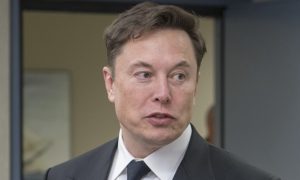
 Elon Musk2 weeks ago
Elon Musk2 weeks agoElon Musk commends Tesla team on successful Robotaxi launch
-

 Elon Musk2 weeks ago
Elon Musk2 weeks agoElon Musk confirms Tesla Optimus V3 already uses Grok voice AI

